Med info
Eye allergies: causes, symptoms, types and treatment at Batal Specialized Complex in Jeddah
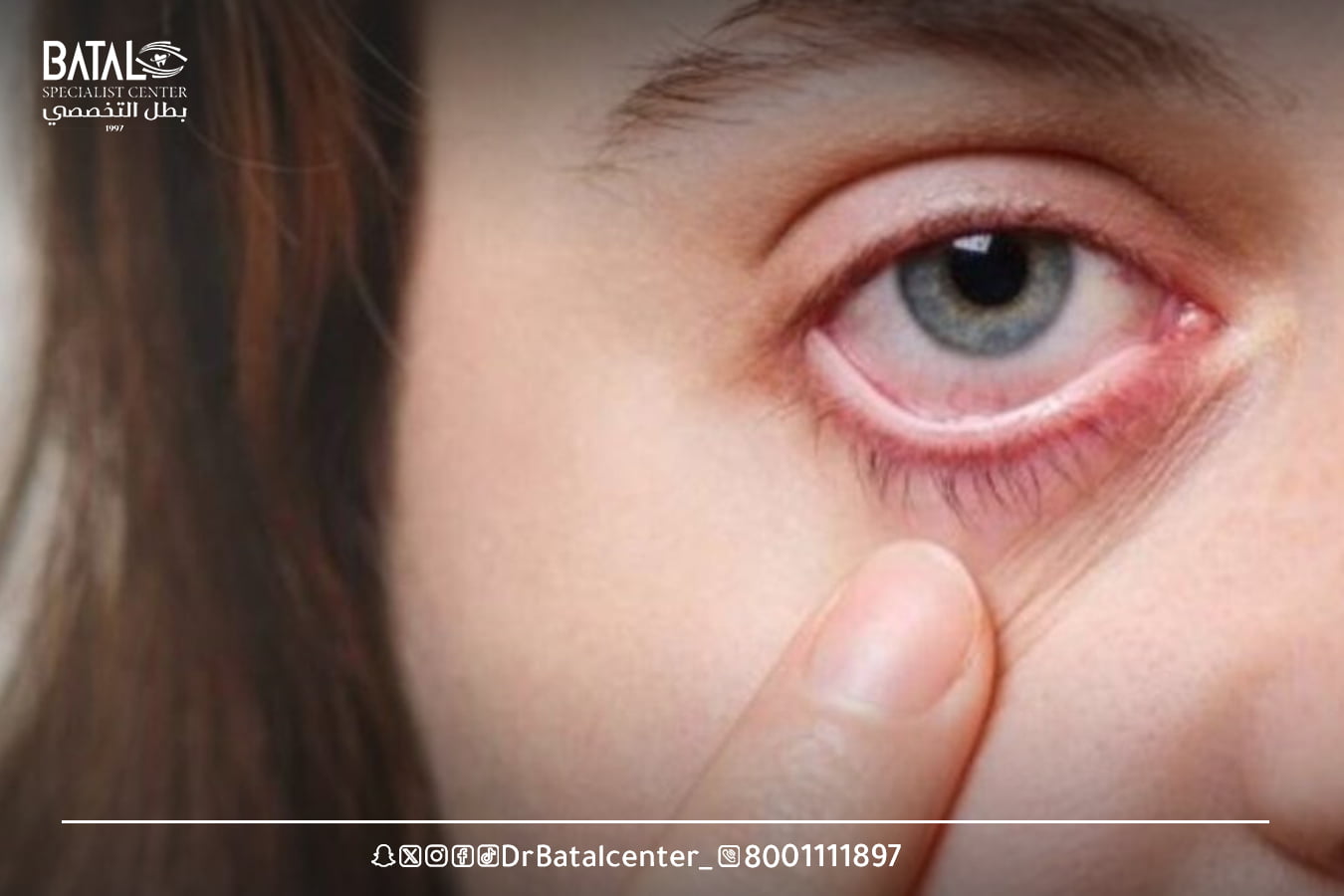
Do your eyes itch, hurt, become red, or swollen? You may be suffering from allergic conjunctivitis, known as eye allergy.
Like all allergies, eye allergies begin when the immune system recognizes a harmless substance as the allergen. This causes your immune system to overreact and produce antibodies called immunoglobulin E (Ige), and these antibodies travel to cells that release chemicals that cause an allergic reaction.
In this case, the reaction occurs in your eyes, and eye sensitivity occurs when the conjunctiva becomes inflamed. This is the mucous membrane that covers the whites of the eyes and the inner side of the eyelid.
What is eye allergy?
Eye allergy, also known as allergic conjunctivitis, is an eye condition in which the body reacts to certain substances that come into direct contact with the eyes, such as pollen or pet dander. This substance then triggers an overreaction in the immune system, which expels the substances as quickly as possible, causing symptoms similar to allergic reactions in the face and eyes.
There are also different types of eye allergies, depending on the presence of allergens or genetic conditions such as vernal keratoconjunctivitis, which is an allergic reaction to certain people’s seasonal climates.
Eye sensitivity in English
Eye allergy is called in English.
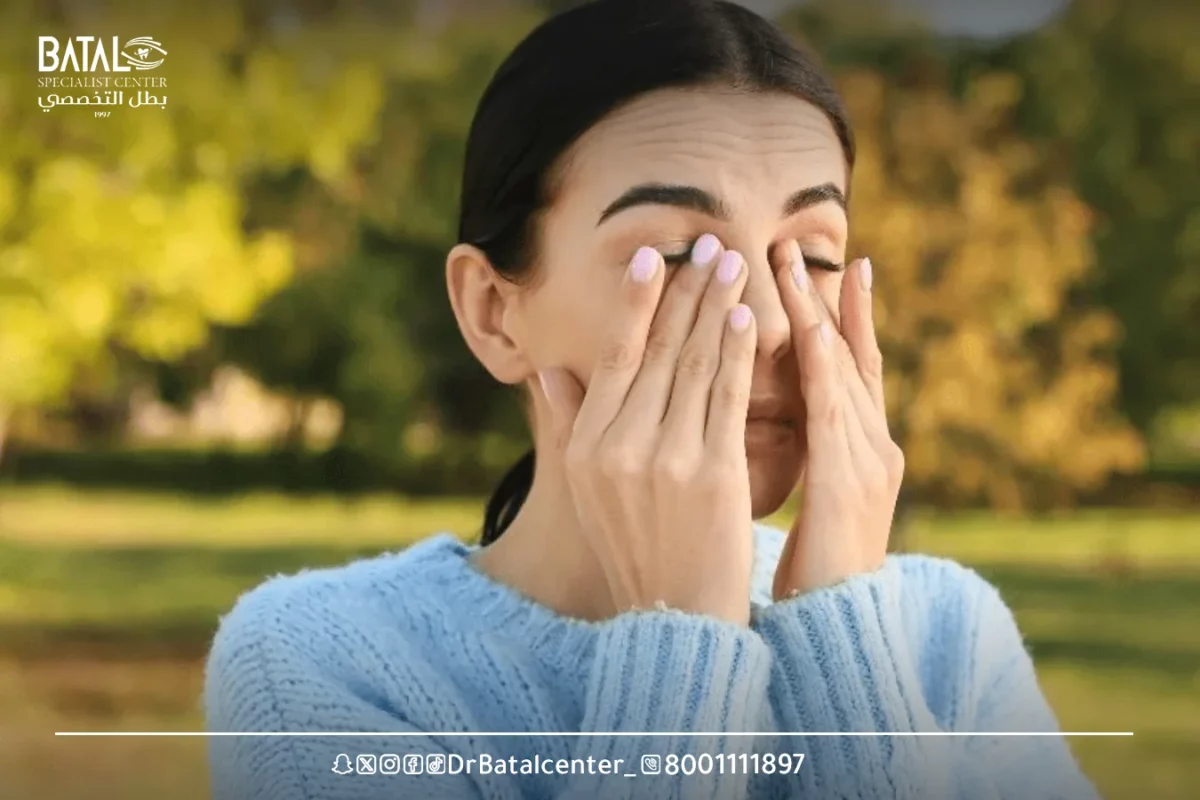
The most common causes of eye allergies
Airborne allergens
Eye allergies occur when the eye reacts to certain substances, triggering an immune response. Here are the main causes of eye allergies:
Many eye allergies are caused by airborne allergens, such as:
- Pollen: Pollen is a cause of eye allergies because the secretion of plant pollen leads to the release of histamine into the body.
- Smoke: Smoke is the cause of eye allergies because smoke particles may be an allergen that leads to an allergic reaction if the particles come into contact with the body or eyes.
- Dust: Dust is one of the causes of eye allergies because the many particles that make up dust may be considered allergenic by the body.

When these allergens come into contact with the eyes, they can trigger an allergic reaction.
Contact with allergens
Direct contact with allergens, such as:
- Pet dander: Pet dander is a cause of eye allergies because pet dander may cause an animal allergy in a person if pet dander comes into contact with the skin or eyes.
- Mold: Mold is the cause of eye allergies because certain types of mold particles, such as Penicillium, can be allergenic and will cause an allergic reaction if they come into contact with the eyes or skin.
- Animal saliva.
- Some cosmetics can cause eye allergies.
Some medications
Some medications, especially those taken orally or in the form of eye drops, can cause allergic reactions in the eye. This can include prescription and over-the-counter medications. If you suspect that a medication is causing eye allergies, it is important to consult your doctor.
Viral or bacterial eye infection
Eye allergies can also occur as a result of viral or bacterial infections, such as conjunctivitis (pink eye). The infection can cause inflammation and irritation in the eye, leading to allergy-like symptoms.
Dry eyes
Dry eye syndrome, which occurs when the eye does not produce enough tears, can make the eye more susceptible to allergens. Lack of moisture can irritate the eyes and can worsen the allergic response.
Eye diseases
Some eye conditions, such as blepharitis or keratoconjunctivitis sicca (inflammation of the cornea and conjunctiva), can contribute to eye sensitivity. These conditions can disrupt the normal functioning of the eyes and make them more susceptible to allergic reactions.
Symptoms of eye allergies and how to distinguish them from other diseases
When you have an allergic eye, the cells lining the conjunctiva release histamine when exposed to allergens and irritants. These allergens and irritants cause conjunctival enlargement and eye allergy symptoms.
Common symptoms include:
- Itchy eyes: Itchy eyes are a symptom of eye allergies and are caused by histamine, which irritates the nerve endings of the eye.
- Water secretion: Water secretion and watery eyes are symptoms of eye allergies and result from the body’s reaction to the chemical histamine and the eye’s attempt to expel irritants.
- Eye redness: Eye redness is a symptom of eye sensitivity caused by an aneurysm in the eye and possibly violent rubbing or touching.
- Burning eyes: Burning eyes and allergies Burning eyes is a symptom of eye allergies and is caused by histamine, which causes inflammation and irritation of the nerves in the eye.
- Feeling sandy or dirty in your eye: Feeling sandy is a possible symptom of eye allergies and results from allergens landing in the eye or from allergy symptoms that cause the eyelids to come into direct contact with the eye.
- Swelling of the eyelids: Swelling of the eyelids is caused by histamine, which makes the eyelids swollen or inflamed.
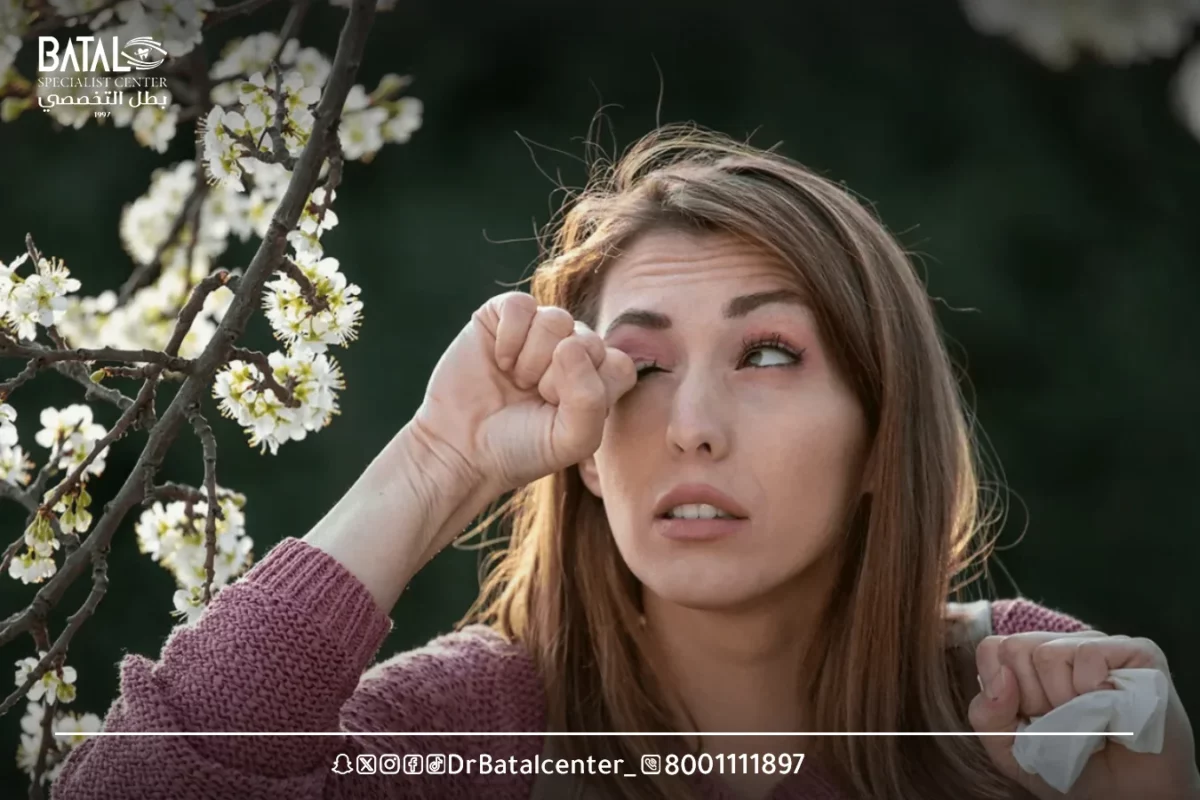
Types of eye allergies
Permanent allergic conjunctivitis
- Permanent allergic conjunctivitis is a type of eye allergy in which the allergen that can be found year-round is directly in the eye, causing an allergic reaction.
- Permanent allergic conjunctivitis differs from other types of eye allergies because the cause of the reaction can be found at home or in the outside world all year round. The allergen may vary from person to person, and the symptoms of permanent allergic conjunctivitis are milder and less severe than those of seasonal allergic conjunctivitis.
- Permanent allergic conjunctivitis is diagnosed by a doctor or eye health professional by examining the eyes and finding symptoms such as redness, swelling, or burning of the eyes as well as mild symptoms of other allergic reactions, such as a runny nose or sneezing. A person’s allergy history and the causes of their allergy can also be checked.
- vernal conjunctivitis
- Spring conjunctivitis is a severe type of eye allergy and the allergic reaction is caused by seasonal allergens directly in a person’s eye and the person is severely allergic to the substance.
- Spring conjunctivitis differs from other types of eye allergies because the symptoms of an allergic reaction are more severe in the eye, and in some cases may lead to permanent blindness if the condition is not treated properly.
- Spring conjunctivitis is diagnosed by an eye health professional by examining the eyes for symptoms such as itching, tearing of the eye, persistent thick mucus formation, a sensation of something in the eye, sensitivity to light, and hard, round bumps that are clearly visible on the eyelid.
- giant papillary conjunctivitis
- Giant papillary conjunctivitis, also known as GPC, is a form of eye allergy in which the inside of the eyelid begins to show symptoms of an allergic reaction, redness, itching, or swelling, and rough cysts begin inside the eyelid.
- Giant papillary conjunctivitis differs from other eye conditions because, although it shares many symptoms and causes with allergic conjunctivitis, such as the possible cause of an allergic reaction, which is contact lenses. A reaction to contact lenses is much more serious and may lead to permanent intolerance to contact lenses
- Giant papillary conjunctivitis is diagnosed by a doctor or eye health professional by examining the eye for symptoms of an allergic reaction, such as itching or redness, and also by examining the inside of the eyelid to see if the surface is smooth or has bumps.
- Allergic keratitis
- Allergic keratitis or seasonal allergic conjunctivitis, also known as SAC, is a type of eye allergy that occurs when an allergen falls on the eye, a substance that causes an exaggerated reaction in the body’s immune system. Seasonal allergic conjunctivitis is closely related to hay fever and is more common during pollen-high seasons.
- Seasonal allergic conjunctivitis differs from other types of eye allergies because it is caused specifically by allergens that occur in the spring and summer and is most commonly caused by grass and plant pollen rather than substances that can be found year-round.
- Seasonal allergic conjunctivitis is diagnosed by an ophthalmologist by examining the eyes for symptoms of allergic conjunctivitis, such as eye redness or itching, dark circles under the eyes, runny eyes or runny nose and other common signs of hay fever.
- Eye sensitivity to light
- Eye sensitivity to light or atopic conjunctivitis is a type of hereditary eye allergy that can occur year-round. Atopic conjunctivitis is caused by a separate genetic condition called atopy, which causes the immune system to produce an excess of antibodies when the body reacts to the presence of allergens.
- Atopic conjunctivitis differs from other types of eye allergies because it is a genetic condition and affects the lower eyelid significantly more than other conditions, such as vernal keratoconjunctivitis.
- Atopic conjunctivitis is diagnosed by a doctor who examines the eye and finds symptoms such as sensitivity to light, itching, burning in the eye, redness and swelling of the eyelids, and watery eyes.
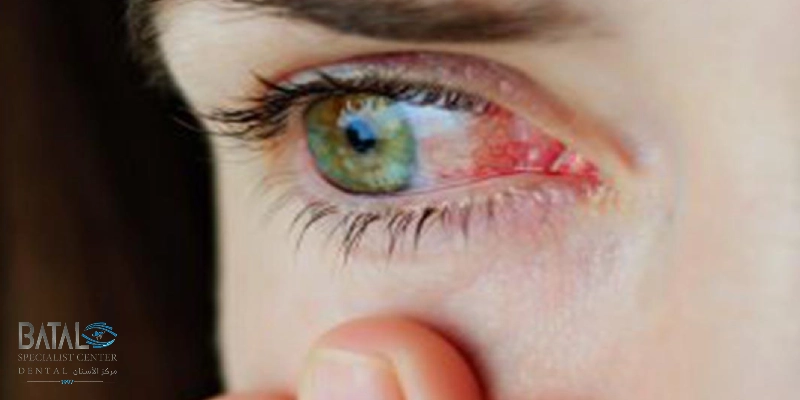
How to diagnose eye allergies at Batal Specialist Complex
Diagnosing eye allergies usually involves a combination of clinical examination and allergy testing. Here are common methods used to diagnose eye allergies:
Clinical examination of the eye by an ophthalmologist
The ophthalmologist will perform a comprehensive eye examination to evaluate the symptoms and signs of an allergy. They will review your medical history, ask about your symptoms, and perform an eye exam to evaluate the appearance of your eyes, eyelids, and conjunctiva.
Allergy tests to identify allergens
- Skin prick test: This test involves applying a small amount of allergen extracts to the skin, usually on the forearm or back. The skin is then pricked with a small needle to allow the allergen to enter the skin. If you are allergic to a particular allergen, you may develop a small, raised bump at the puncture site, indicating a positive reaction.
- Blood test: A blood test, such as an IgE (immunoglobulin E) test, may be performed to measure levels of specific antibodies produced in response to allergens. It can help identify specific allergens that may be causing eye allergies.
- Spot test: Small spots containing various allergens are placed on the skin and left for a specified period of time. If a reaction occurs at the site of a particular allergy patch, this indicates an allergic response to that specific substance.
Treating eye allergies: from drops to immunotherapy
Treating eye allergies involves a range of strategies aimed at relieving symptoms and reducing exposure to allergens. Here are some common ways to treat eye allergies:
Avoid allergens
The first step in managing eye allergies is to reduce exposure to the allergens that cause the symptoms. This may include avoiding outdoor activities during peak pollen times, keeping windows closed to prevent pollen from entering your home, using air purifiers, and cleaning bedding and carpets regularly to reduce dust mites.
Oral drops and medications
- Antihistamine eye drops: Over-the-counter or prescription antihistamine eye drops can help relieve itching, redness, and swelling in the eyes. These eye drops work by blocking the effects of histamine, a chemical released during allergic reactions.
- Mast cell stabilizing eye drops: These eye drops help prevent the release of histamine and other chemicals that cause inflammation and allergy symptoms. It is often used for long-term management of eye allergies.
- Decongestant eye drops: Decongestant eye drops can provide temporary relief from eye redness and swelling. However, it should not be used for more than a few days, as prolonged use can lead to rebound redness and other side effects.
- Oral antihistamines: Oral antihistamines may be recommended to relieve allergy symptoms within the body, including itchy eyes and sneezing. It works by blocking histamine throughout the body.
Home remedies
- Cold compresses: Applying a cold compress or towel to the eye can help reduce itching and swelling.
- Frequent eye washes: Using artificial tears or saline eye drops can help remove allergens from the surface of the eye and provide temporary relief.
- Avoid rubbing the eyes: Rubbing the eyes may worsen symptoms and possibly lead to further irritation. It is important to resist the urge to rub and use other methods instead to relieve discomfort.
Immunotherapy
In cases of severe or persistent eye allergies that do not respond well to other treatments, immunotherapy may be considered. Immunotherapy involves regular injections or tablets under the tongue that expose the body to gradually increasing doses of allergens, which helps desensitize the immune system over time.

Complications of negligence in treating eye allergies
Complications of eye allergies are long-term eye damage, vascular scarring, and keratitis in cases of severe eye allergies. The following are complications of eye allergies:
- Eye damage: Eye damage is a complication of eye allergies when a person repeatedly touches, scratches, or rubs the irritated eye forcefully, which can cause long-term damage to the eyes if done too often or too violently. Eye allergies in themselves do not cause such damage to the eye.
- Vascular scarring: Vascular scarring is a rare complication of eye allergy and occurs if the eye allergy is so severe that the symptoms cause new blood vessels to appear in the eye and leave scars so severe that they can only be repaired with surgery.
- Inflamed cornea: Inflamed cornea is a complication of eye allergies, medically known as keratitis. This causes damage to the cornea and can lead to scarring and permanent blindness.
Tips from Batal Specialized Complex doctors to prevent eye allergies
Eye allergies can be prevented by first determining the exact cause of the allergic reactions. Second, contact with the source should be avoided once it is identified to completely prevent the symptoms and causes of eye allergies.
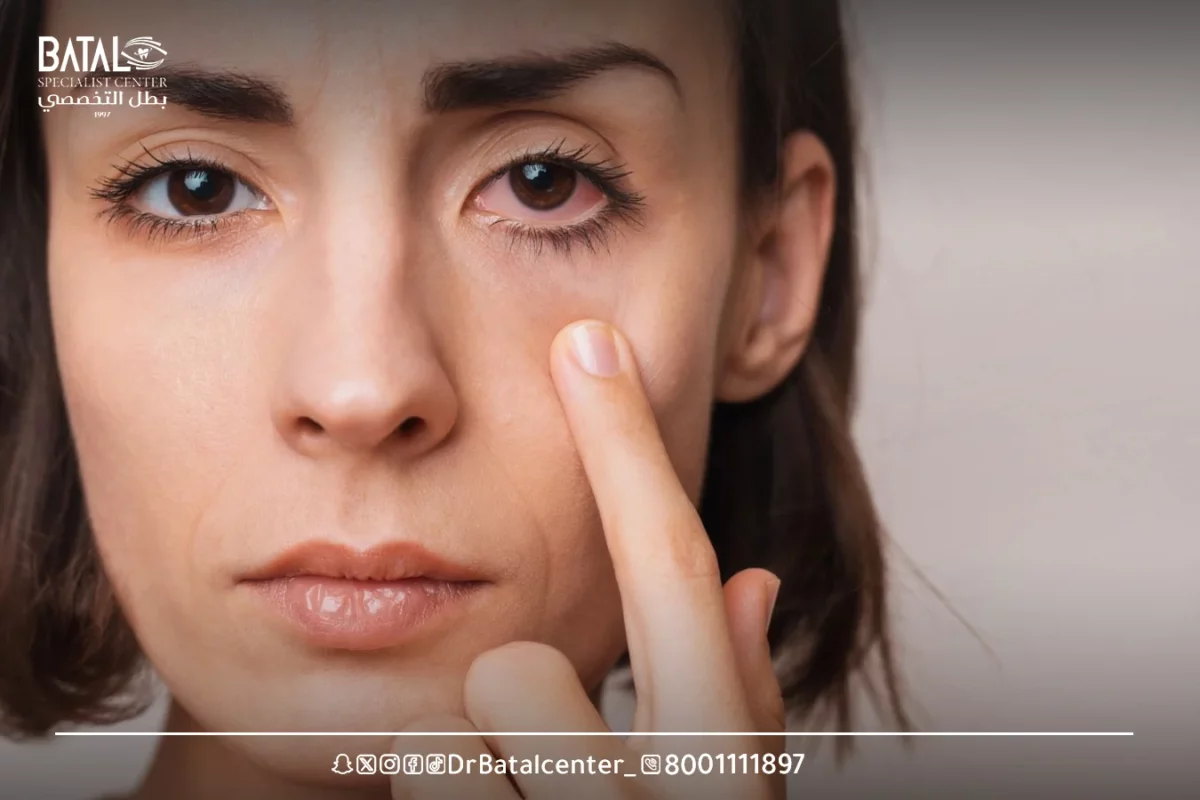
One of our doctors’ most important tips for preventing eye allergies is:
- Do not touch or rub your eyes.
- Wash your hands often with soap and water.
- Use a vacuum cleaner with a certified asthma- and allergy-friendly filter to reduce exposure to allergens.
- Wash bed linen and pillowcases with hot water and detergent to reduce allergens.
- Keep pets away from the bedroom to reduce allergies to pet dander in the bed.
- Wear sunglasses and a wide-brimmed hat to help prevent pollen from getting into your eyes.
- Keep windows closed during high pollen and mold seasons. Use air conditioning in your car and home, and also consider using an approved air filter.
Get ready for the comfort of your eyes with the experts of the Specialized Champion in Jeddah
At Batal Eye Specialist Complex, we care about treating all types of eye allergies using the latest, globally reliable diagnostic and treatment technologies.
Our team of ophthalmology consultants offers precise treatment plans that include advanced drug drops, immunotherapies, and periodic follow-up to reduce the recurrence of allergies and protect the cornea.
Book your examination today at Batal Specialized Complex in Jeddah and enjoy comfortable vision free of itching and redness with integrated visual care from eye experts.



